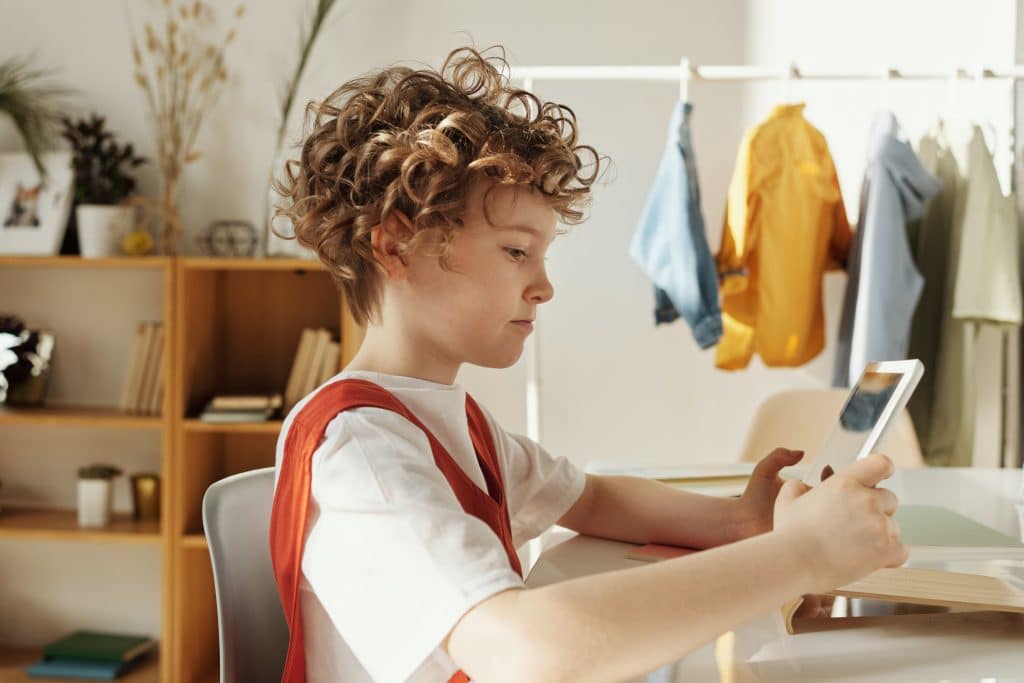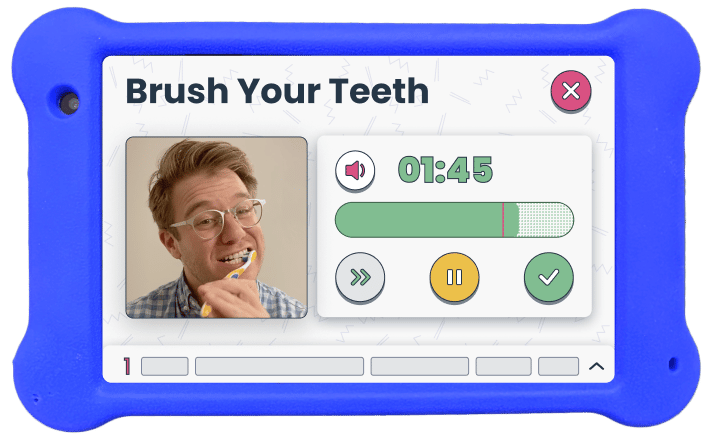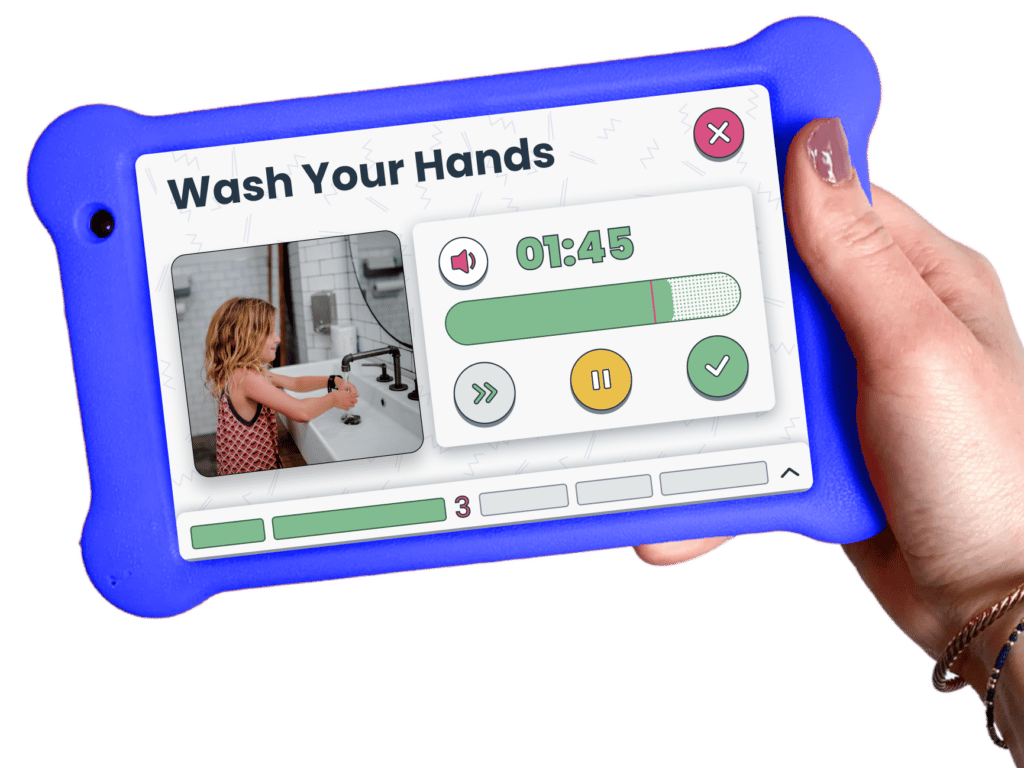Does your kiddo struggle to stay on track? Are mornings before school a nightmare? Do your kids do great at school but at home, they struggle without visuals and schedules? Especially if they respond well to video modeling, start establishing routines, and use visual schedules at home for kids with autism.
Table of Contents
Why Are Visual Schedules at Home for Kids With Autism So Beneficial?
Structure is crucial for all children, but it’s even more important for neurodivergent children. Having a set structure and routine will make your child’s day predictable and easy to break down into individual parts.
Children with autism can get overwhelmed easily if something doesn’t go in the way that they expect. They may struggle to control their emotions when something doesn’t go to plan, even if it seems somewhat inconsequential to you as their parent.
Children with autism or ADHD sometimes struggle with self-control. This can cause them to “wander off” a bit when they’re supposed to be doing things. They lose track of time.
All kids need a structured plan in place to complete their tasks – learning comes differently to everyone. At one point, you had to learn your own bedtime, morning, and chore routines too!
Structure will also help your child develop habits so they can continue completing tasks on their own. Children who don’t get this type of guidance may struggle as adults. Visual schedules for kids with autism or ADHD can really help with routines at home.
Starting a New Routine With a Visual Schedule at Home
Starting a routine with a visual schedule for a kiddo with autism can be challenging. Here’s the thing, no one likes to be bossed around. Work together with your child to create the routine. Your child’s internal clock is unique, so you want to work with it, not against it.
After you input all of the “must-dos” (such as going to school, for example), work around that time to schedule everything that your child is going to do.
What time should we eat dinner? When do we have to wake up in the morning? When is bedtime?
Put everything into time blocks with your kiddo and find visual aids that work. Visuals in visual schedules at home help kids with autism (and really all kids!) know what to do in each step of the routine (more on that later) so your child can keep track of it.
You’re also going to want to have both large and small routines. A full-month calendar paired with weekly and daily calendars will make the routine seem more digestible for your child.
Read more: Weekly Schedule Template for Kids

Read more: Best homeschool app
Encouraging Your Child To Stick With A Routine
Creating the routine is one thing. Getting your child to stick with it is a whole other beast altogether. Your child will put up some resistance at first, and that’s okay.
There are a few things that you can try to help encourage your child to maintain their routine after you set it. Here are a few tips.
Break Down the Routine Into Bite-Sized Steps
If your child is struggling with their routine, consider that it may still be too complicated for them. Breaking each block of time into smaller parts will make it far easier for them to do everything.
If part of the child’s nighttime routine is just “get ready for bed,” this isn’t enough for a child with ADHD. Something so vague can cause them to shut down (especially at a time when meltdowns aren’t uncommon).
Break it down into individual steps. What’s the first thing that your child does when they get ready for bed? What are the individual steps that go into that thing?

Show Them The Benefits (Use Rewards!)
Children struggle to understand why they’re supposed to do things that they don’t want to do. Adding more structure to their lives seems restrictive. Show them why a visual schedule at home is actually going to make their life better.
Talk to them about natural consequences. If your child follows their routine, it means that they get to playtime on time every day.
Offer incentives and rewards if natural consequences aren’t enough. Use a tool like Goally to track your child’s progress and reward them when they stay on task!
Be Consistent
Especially when you’re first getting started using visual schedules at home, you want to stay as consistent as possible with your child’s routine. This means that you may have to make weekend routines similar to school day routines until your child develops habits.
For example, if your child goes to bed at 9 pm every school day, you should also put them to bed at 9 pm when they don’t have school the next morning.
While they don’t need to go to school, replace school in their visual schedule at home with something else. They may have an hour of learning time, a set playtime, and set times for chores.
When you block that time in a similar slot as their “school” slot, it will help with consistency so your child knows what to expect!
Use Plenty Of Reminders
In the beginning, we all need help remembering things in our routines. It takes a while to nail down your morning routine when you start a new job, new school, etc. Think of that in the same way when you start implementing new routines with your kiddos.
By using visual schedules and audio reminders at home, you’ll help kids with autism who respond well to modeling start to develop habits! Visual reminders include things like posters, gestures, and physical schedules that they can see and touch. Place these things around the home in areas that your child has easy access to.
Goally allows you to set audio reminders for your child as well. By including reminders that use multiple senses, your child will pick up the habit more quickly.

"Our Goally has been amazing for helping my son with transitions. Leaving the house is much easier now using his "Go Bye Bye" routine and he loves hearing my voice reciting the steps for him. It's a total game changer when it comes to visual schedules" — Paige Learn more →
Visual Schedule for Autism: A Game-Changer for Your Child’s Routine at Home
Creating a structured routine and implementing a visual schedule for your child with autism at home may seem daunting initially. However, with patience and consistency, you’ll witness the significant impact it can have on your child’s productivity, happiness, and overall ability to function.
Here are a few key points to keep in mind:
- Consistency is Key: Stick to the established routine and visual schedule to provide a sense of predictability and security for your child.
- Visual Supports: Utilize visual aids such as pictures, symbols, or written words to help your child understand and follow the schedule more effectively.
- Patient and Persistent: Be patient as your child adjusts to the new routine, and persistently reinforce the visual schedule to promote understanding and independence.
- Monitor and Adjust: Regularly assess the effectiveness of the visual schedule and make any necessary adjustments to better suit your child’s needs and preferences.
Goally | Apps To Structure Your Kiddo’s Routine
Does your child struggle with transitions or staying on task? Goally’s visual schedule app breaks down large tasks into small, achievable steps. It helps kids complete their tasks independently!
By embracing a visual schedule and providing a consistent routine, you’re setting the stage for your child’s success in navigating daily activities and promoting their overall development. Keep up the fantastic work!
FAQ’s About Visual Schedules for Autism
What is a visual schedule for autism? A visual schedule for autism is a visual tool that uses pictures, symbols, or written words to help individuals with autism understand and follow daily routines or tasks.
How can a visual schedule benefit a child with autism? A visual schedule provides structure, predictability, and visual cues, which can help reduce anxiety, improve communication, promote independence, and enhance overall understanding of daily activities for children with autism.
How do I create a visual schedule for my child with autism? To create a visual schedule, choose appropriate visual supports such as pictures, symbols, or words, organize the schedule in a sequential manner, and make it easily accessible and visible to your child.
When should I use a visual schedule for my child with autism? Visual schedules can be beneficial in various situations, such as morning routines, daily chores, transitions, and special events. Determine the specific areas where your child may benefit from visual supports.
How can I make the visual schedule more effective for my child with autism? Customize the visual schedule to match your child's preferences and needs, involve them in the process, use consistent visuals, provide visual prompts or reminders, and offer positive reinforcement for following the schedule.
This post was originally published on 02/18/2022. It was updated on 05/31/2023.

Goally
We help parents teach their kids life skills, like doing bedtime and morning independently. Backed by science, we incorporate evidence-based practices and expert-informed designs in all of our apps and content.






